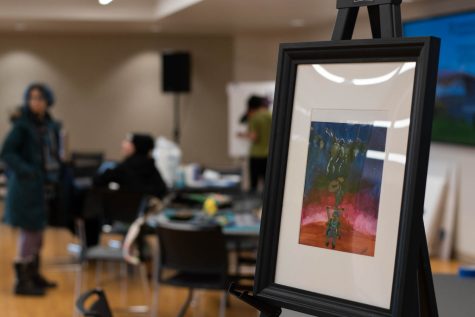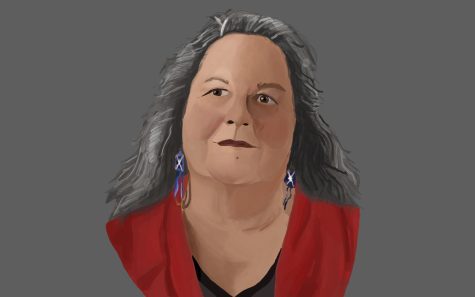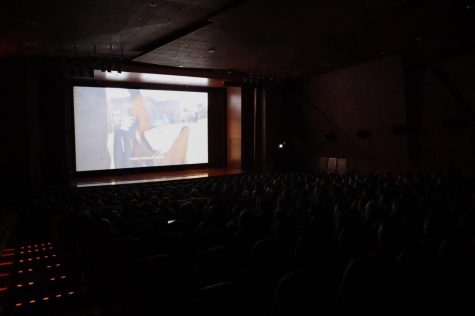Through the lens; Museum of Art showcases iconic photos

Vivian Maier’s 1955 “New York City, September 10” is on display at the WSU Musuem of Art’s new exhibit “Through the Lens: An American Centruy – Corbis & Vivian Maier.”
January 12, 2015
In most cases, public and private affairs are kept as far apart as possible. The curators at the WSU Museum of Art, however, felt this separation needed to be overcome for their new exhibit, “Through the Lens: An American Century – Corbis & Vivian Maier.”
The exhibit is separated into three sections: a collection from Corbis, a collection from Vivian Maier, and a collection from university students, said Debby Stinson, marketing and PR manager at the Museum of Art (MOA.)
“Corbis was one of the first stock photo companies,” Stinson said. “Stock photo companies started popping up in the early ‘80s, collecting photos and renting them out to businesses.”
Stock photo companies allow photographers to get paid long term for a single image. Any time a business wants to print a photo, whether on a shirt or a journal, the artist gets paid, she said.
“Corbis is a collection of some of the greatest images of the last 100 years,” Stinson said.
The photos selected from the Corbis collection are considered recognizable and well known by the public, said Zach Mazur, curator of education and collections at the MOA.
However, this exhibit tries to focus on a “slightly different version of the photos we know,” said Ryan Hardesty, curator of art and exhibitions at the MOA.
“For example, the photo we selected of Marilyn Monroe was taken at the same shoot as the iconic wind-blown dress photo, but this particular image shows all of the photographers at the shoot, as well as the set up for the image,” Hardesty said.
The Corbis show is described as a “documentary,” with images that relate directly to major parts of our history. Because Corbis collects famous photos, as a team the MOA staff had to pick and choose what images made the cut, Mazur said.
“To put photos on the wall, they had to be great photos, recognizable, and start a discussion,” Mazur said. “This meant we missed many moments in history.”
The Corbis collection is a look at public events, while the second section of the exhibit looks at private life through the eyes of Vivian Maier.
“(Maier) was a nanny for a living, and took photos of things she saw in town as she went about daily life,” Stinson said. “Nobody knew she was taking these pictures.”
All of Maier’s negatives, film and photos were purchased after her death by John Maloof. He has slowly been revealing her photos to the world, she said.
“Her images were a private look of the world the way she saw it,” Stinson said. “She created a private portrait of the world through her eyes.”
Since Vivian Maier died before her photos were ever revealed to the world, the public has no way of knowing how she would feel about her recent fame, Mazur said. However, it is safe to assume that she would not be happy to have her images seen by so many people.
“Nobody really knows her story. She has no known family or relationships,” Hardesty said. “We have to be careful of what we tell the public, because we don’t want to invent her story.”
The Maier collection is as private as they come, depicting intimacy, children, and street life that is not usually noticed, Mazur said.
Not only was Maier capturing private life, she was also conspicuous about it, using a Rolex camera that allowed her to take the image from her waist, never letting on to her subject what she was doing, Mazur said.
“She was kind of like a spy,” Hardesty said. “She was able to get photos without being noticed.”
Maier also took self-portraits in mirrors and windows, which may be the only photos she is in, Stinson said.
The stark contrast between the two different collections, the public images that are known around the world in the Corbis collection, and the private, never-before-seen images found in Vivian Maier’s collection are brought together with a selection of images taken by current university students from around the United States.
“I am creating an interactive map that shows the location of the different students we selected, and the pieces they submitted to be a part of the exhibit,” Mazur said.
The MOA staff hopes that both sections of the exhibit will get people thinking and talking. They want visitors to think “I remember what I was doing when that happened” when looking at the Corbis images, and “I know how that feels” when looking at the Maier images, Mazur said.
“This show is about how the audience responds to the photos,” Hardesty said. “Not so much about the genre as response and feeling.”
The show is linked to several different events: the exhibit itself, Jan. 12 – April 3; a reception and gallery talk by Dennis Dehart, Jan. 22 from 5:30 – 7:30 p.m.; a second reception considering Vivian Maier, Feb. 12 at 6 p.m.; a screening of the film “Finding Vivian Maier” on Feb. 12 at 7 p.m.; and a student discussion panel (TBA).




















